Rajgira Sheera, also known as Rajgira Halwa—is a rich, wholesome, and utterly delicious Indian dessert made using Amaranth flour (rajgira atta). Naturally gluten-free and packed with nutrients, this sweet dish holds a special place in Indian households, especially during religious fasting days or vrat/upvas.
What truly sets Rajgira Sheera apart is its irresistible melt-in-the-mouth texture, combined with a divine, nutty aroma that fills the kitchen as it cooks. Its charm lies in its simplicity—made with just a handful of vrat-friendly ingredients, yet rich in flavor and tradition. Cooked slowly in pure ghee, sweetened with sugar or jaggery, and flavored with cardamom, it turns into a comforting delicacy that feels both indulgent and nourishing. A handful of chopped nuts like cashews, almonds, or raisins are often added to enhance its richness and add a delightful crunch.
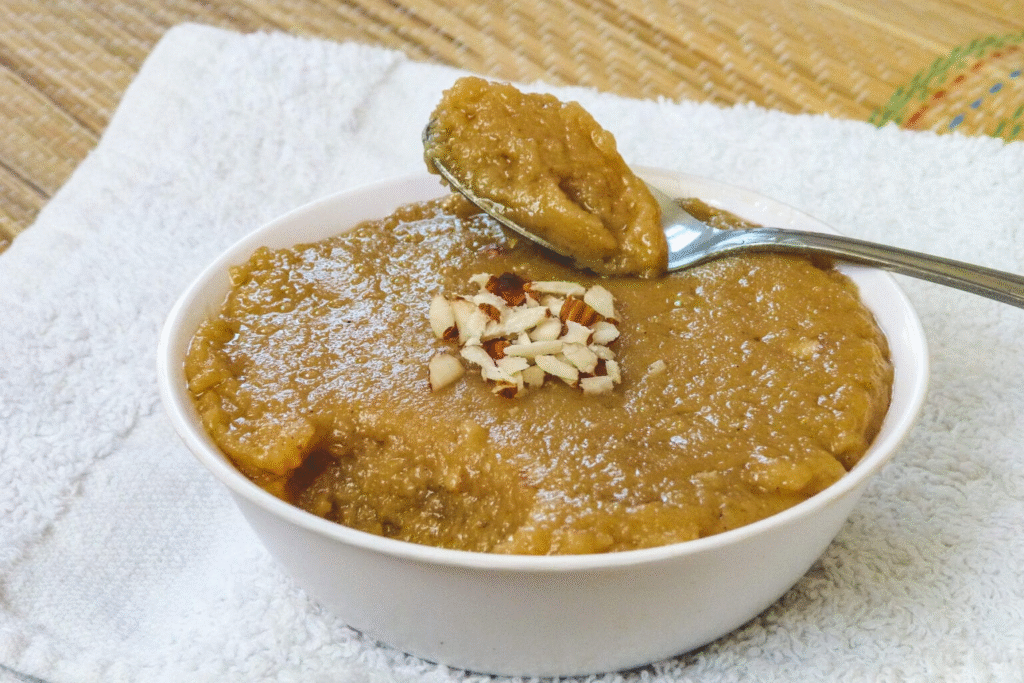
All the ingredients used—rajgira atta, ghee, sugar/jaggery, cardamom, and dry fruits—are allowed during most Hindu fasts, making it a perfect treat for auspicious days like Navratri, Ekadashi, Mahashivratri, or Shravan Mondays.
Whether you’re observing a fast or simply craving a warm Indian sweet, Rajgira Sheera is a wonderful choice. It’s not just festive but also easy to digest, making it suitable for people of all ages. With its nutty taste and creamy texture, this vrat-friendly dessert is sure to win hearts—one spoonful at a time.
❤️ About This Rajgira Sheera Recipe
Rajgira Sheera has a slightly sticky and gooey texture that tends to cling to your spoon or bowl. But don’t be fooled — once you take a bite, that stickiness vanishes, leaving behind a melt-in-the-mouth smoothness. This perfect balance comes from using just the right ratio of ghee to rajgira flour. So, don’t skimp on the ghee — it plays a crucial role in achieving that luscious consistency.
During fasting days, energy levels often dip, leaving you feeling drained. That’s when a small serving of this sheera can work wonders. Packed with the richness of ghee and the wholesomeness of amaranth flour, it provides a satisfying boost of energy while keeping you full for hours.
This comforting dish carries fond memories for me — it’s my mom’s special recipe. She lovingly made it for me during the Gauri Vrat when I was a child. Back then, it was the highlight of my fasting days. In Gujarati households, we call it Rajgara no Sheero, and it continues to hold a nostalgic place in my heart.
🧾 Ingredients For Rajgira Halwa
Here’s a picture of all the ingredients you’ll need to make this rich and comforting Rajgira Sheera. The recipe calls for just six simple ingredients and takes only 20 minutes from start to finish. Rajgira atta (amaranth flour), ghee, sugar, and milk come together as the foundational elements of this halwa, creating a rich, velvety texture and infusing it with a naturally earthy, nutty essence that’s both comforting and indulgent.
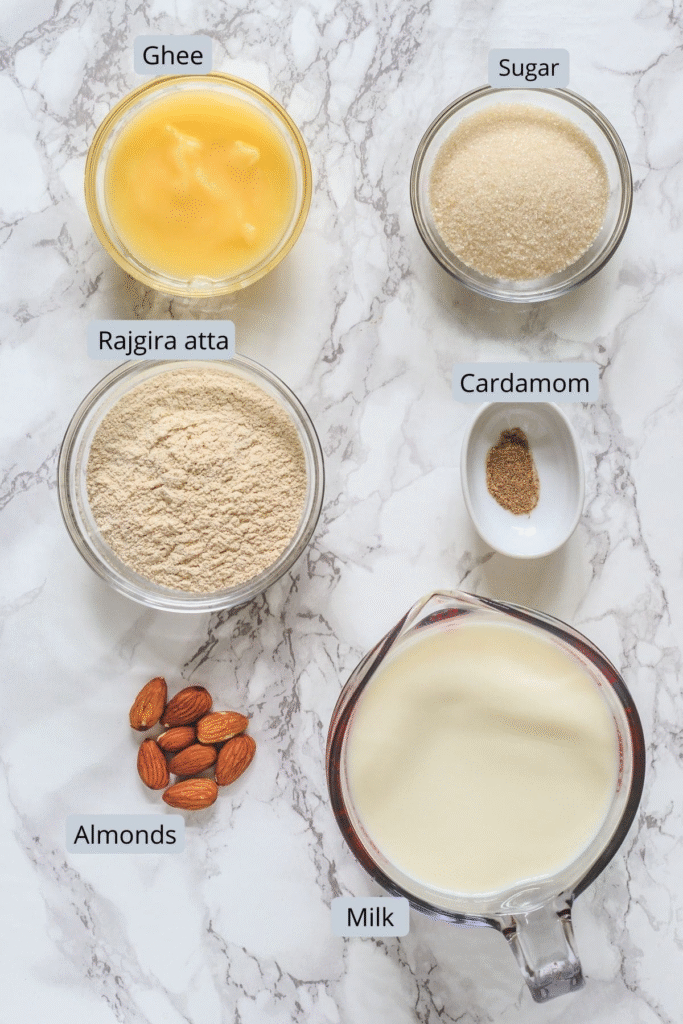
The other two — cardamom powder and sliced almonds — are used to enhance the overall taste and aroma, as well as to add a touch of elegance with their garnish. Despite its simplicity, this vrat-friendly dessert delivers rich flavor and nourishment, perfect for when you’re fasting or simply craving something sweet and wholesome.
👩🍳 How To Make Rajgira Sheera? (Pics)
1) Warm the Milk and Sugar Pour milk into a saucepan, add sugar, and place it on medium heat. Stir gently and heat until the sugar dissolves completely and the milk is nicely warm—no need to bring it to a boil. Alternatively, you can microwave the milk and sugar mixture for a minute or two until just warm.
2) Heat Ghee in a Pan In the meantime, warm ghee in a heavy-bottomed pan or kadai over a gentle medium-low flame, allowing it to melt slowly and release its rich aroma. Let it warm up fully before moving to the next step.
3) Roast the Rajgira Flour Add rajgira atta (amaranth flour) to the melted ghee. Keep stirring continuously using a flat spatula to avoid any lumps or burning. At the same time, keep an eye on the milk mixture so it doesn’t overheat.
4) Cook Until Aromatic Keep sautéing the flour gently until it takes on a light golden hue and fills your kitchen with a warm, nutty aroma that signals it’s perfectly roasted. This step is crucial for enhancing the flavor of the sheera.
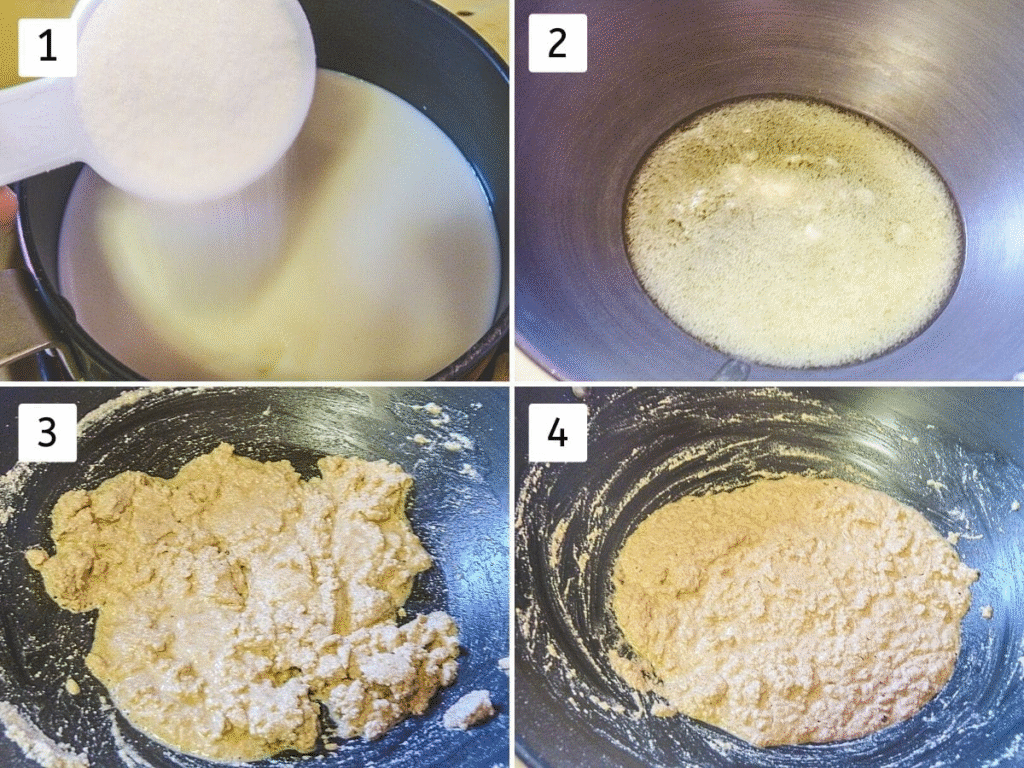
5) Add the Warm Milk Mixture Once the flour is well-roasted, slowly pour the warm milk-sugar mixture into the pan. Exercise care during this step, as the mixture can bubble up rapidly and splatter when exposed to the sudden shift in temperature.
6) Stir Immediately and Vigorously As soon as the milk is added, stir everything together briskly to prevent lumps and ensure the mixture is smooth and even.
7) Cook Until It Thickens Continue cooking the sheera on low heat, stirring constantly. The mixture will start to thicken as it absorbs the liquid. Keep going until all the moisture evaporates, ghee starts to separate and release from the sides, and the sheera leaves the sides of the pan easily. At this point, turn off the heat.
8) Finish with Flavor and Garnish Sprinkle in cardamom powder for aroma and flavor, and toss in some chopped nuts like almonds or cashews for crunch. Mix well one last time and serve warm.
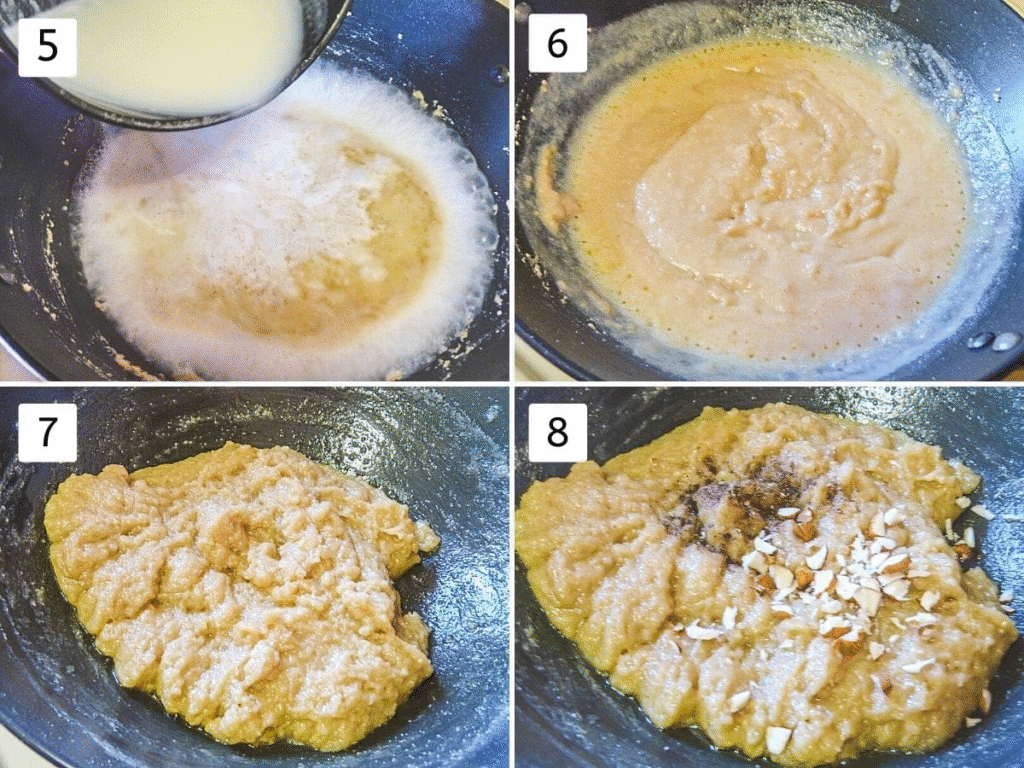
💭 Expert Tips For Rajgira Halwa
Properly roasting the flour is crucial for achieving the rich flavor of rajgira halwa. Take your time with this step—slow-roast the flour over medium-low heat until it turns aromatic and golden. This patient roasting process enhances the nutty depth and ensures the halwa tastes just right.
There are a few clear indicators that let you know the flour has been roasted to perfection:
- – A rich, nutty aroma fills the kitchen: One of the first and most noticeable signs is the fragrance. As the flour toasts in the ghee, it releases a warm, nutty scent that signals it’s cooking properly. This aroma becomes deeper and more intense as it gets closer to being fully roasted.
- Texture change – it becomes lighter and looser: As the flour roasts, it undergoes a subtle but important transformation in texture. Initially, the flour feels dense and heavy when stirred, but as it cooks, it begins to feel much lighter and flows more freely. This shift makes stirring easier and indicates the moisture content is reducing and the roasting process is on track.
- Ghee begins to separate and glisten around the edges: Another sign that you’re almost there is the appearance of ghee slowly separating from the mixture. You’ll notice a slight shimmer as the ghee starts to release from the sides of the pan, giving the mixture a glossy finish. This is a key signal that the flour has roasted well and is ready for the next step.
🥣 Storage & Re-heating
- Store any remaining halwa in a clean, airtight container and place it in the refrigerator. It stays fresh and flavorful for up to 7 days when properly chilled. This ensures the dessert remains fresh and safe to consume later. When you’re ready to enjoy it again, keep in mind that this halwa tastes best when served warm, as the heat revives its rich aroma and smooth texture.
- To reheat, take only the portion you intend to eat and place it in a microwave-safe bowl. Warm it in short bursts of a few seconds, stirring in between if needed. Be careful not to overheat, as doing so can alter its consistency—making it dry, rubbery, or chewy instead of soft and melt-in-the-mouth. If you’re not using a microwave, you can gently warm it on the stovetop over low heat while stirring continuously. For added richness, you may even stir in a tiny spoon of ghee while reheating to restore its shine and flavor.
- Avoid reheating the entire batch repeatedly. Instead, reheat only the needed quantity each time to maintain the halwa’s taste and texture across multiple servings.
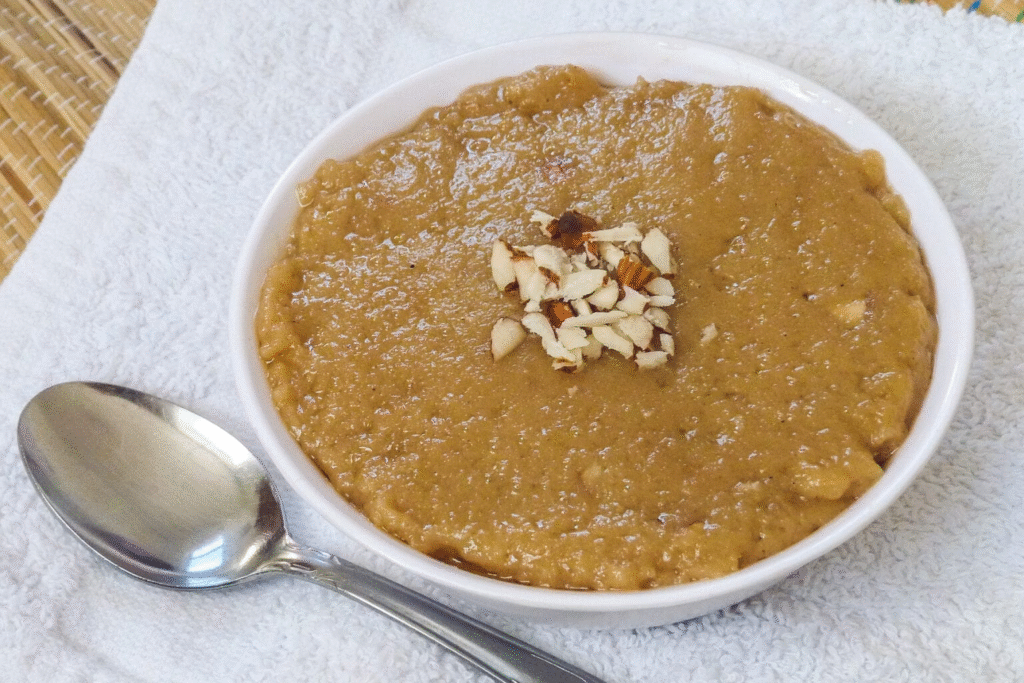
Notes
Properly Roasting the Flour: The Secret to Delicious Rajgira Halwa
Achieving the perfect flavor and texture in Rajgira Halwa starts with one crucial step—thoroughly roasting the amaranth flour (rajgira atta). This step cannot be rushed. Take your time and roast it patiently over medium-low heat for the best results.
But how do you know when the flour is roasted just right? Watch out for these telltale signs:
- A rich, nutty aroma begins to fill your kitchen, signaling that the natural oils in the flour are being released and the raw taste is cooking off.
- The texture of the flour starts to change—it feels noticeably lighter and looser than when you started. Stirring becomes easier as the flour loses its raw density.
- You’ll also notice ghee beginning to separate and gently seep from the sides of the mixture. This is a clear indicator that the roasting is nearing completion
Roasting the flour to perfection ensures that your halwa turns out flavorful, smooth, and aromatic—never raw or pasty. Don’t skip or skimp on this step; it’s the foundation of a truly delightful rajgira sheera.
